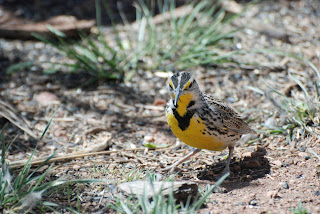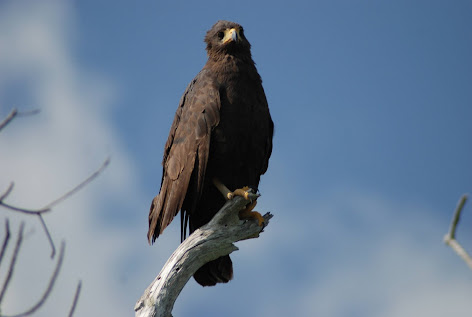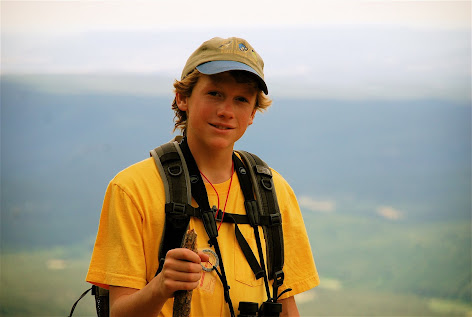
During the time I last posted here and now I have done many things. I've completed 8th grade and am now getting ready for high school. I had a great last semester at the charter school I go to. We studied the impact of wind power and how it compares to fossil fuels such as coal and oil. As we now know, an oil disaster can have dire effects and coal is as dirty a fuel as you could ask for. For wind power , the biggest disaster that has happened is a turbine being struck by lightning and blowing up. Anyway, the 5th thru 8th grades at my school studied wind power and we all decided if we were in favor of or against a local proposed wind facility. It is supposed to be built on a mesa about 30 miles from my house. We also made "voice threads" on our personal opinions on the wind farm. A voice thread is pretty much a diologue with pictures (kind of like a podcast).
 |
| Western Meadowlark |
 |
| Lewis's Woodpecker |
I've also (obviously) been birding. My dad and I led the effort for the San Miguel County International Migratory Bird Day Count and organized a big part of it. The IMBDC is a national event and each county conducts it's own count. There are usually teams of about 2-3 people and they go on separate routes. I started the day with a friend and local biologist, Lea Knutson. We got up around 5:30 AM and got out of the house by 6:00. All of the places we went to would probably be unfamiliar to anyone who does not live in New Mexico but I'll list them anyway. First, we went down a dirt road near Lea's house where we saw Lark, Chipping, and White-crowned Sparrows and stopped at a orchard about 2 miles down the road. It was pretty productive: we saw Bullock's Orioles, House Wrens, a Swainson's Hawk on a nest, Yellow-rumped Warblers, and a few more species.
 |
| Yellow-rumped Warbler |
After stopping there we got to Ruby Ranch, a privately owned cattle ranch that occasionally lets birders in. It is a great place to bird (one of the best hot spots in the county) and we had a pretty good day there. We spent a lot of the time walking along the stream that comes through the ranch and saw birds such as Yellow, Yellow-rumped, and MacGillavary's Warblers. Our best bird was a Northern Waterthrush, a fairly uncommon bird in northern NM. It was my first for the state too. We only got a brief glimpse but it's distinctive behavior and markings have it away. Besides tromping through willows and cottonwoods we visited the 2 lakes in the ranch. Besides from seeing some normal New Mexican waterbirds (Northern Shoveler, Ruddy Duck, Clark's Grebe, etc.) we saw what was probably the most swallows I've ever seen. There must have been 1,500 swallows (on just one lake!) and all 6 species that we could have seen!! There were 800+ Cliff Swallows, 500+ Northern Rough-winged Swallows, 250+ Barn Swallows and lesser amounts of Violet-green, Tree, and Bank Swallows. I was so excited that I totally forgot to pick up my bird book when we left! (I came back later to pick it up when I realized I'd left it).
After birding Ruby Ranch for 3 plus hours we went into Las Vegas and had a much needed lunch. Then Lea and I hooked up with my dad and the person birding with him. We all hopped into one car and drove to La Liendre Road (near Las Vegas) where we walked around a bit. We got quite good at distinguishing Cassin's and Western Kingbirds because we saw at least 20 of them. We also saw Lark Buntings, Lark Sparrows, a Bewick's Wren, and a very cute hummingbird nest! (pictured below). The eggs were barely bigger than my pinky! It was a wonder that we found it at all. It was only 2 feet off the ground and in a Juniper branch.
 |
| Lazuli Bunting |
|
After all that birding we weren't done yet! We took a 2 hour break and then all (including Lea's son) drove up to Johnson Mesa- a great place to hike and bird. We waited until it was getting dark and then split up into owling teams, (I was with my dad and Jamie (Lea's son) and Lea was with the other person who had come along). We then hiked in opposite directions and started calling for Spotted Owls. Johnson Mesa is one of the very few places where Spotted Owls have been documented in northern New Mexico and we were doing a survey to see if we could find any. We didn't see or hear any Spotted Owls in the 4 hours we were hiking but my dad, Jamie and I got great looks at a pair of Northern Pygmy-Owls. We didn't even try to call them in either! We just happened to walk around a corner and, bingo! there they where! They were very upset that we had come in their territory and were calling non-stop. We had a quick look and then left them be. Unfortunately I did not have my camera or I would have put pictures of them on here!
Another thing that I've done is that my family has gotten two cute little kittens (picture below)! We got them from a friend who rescued them from a dumpster.
 |
| Tired kittens |
|
|
|
 |
| My dog Zia being crazy |


























